|
|
|
Sort Order |
|
|
|
Items / Page
|
|
|
|
|
|
|
| Srl | Item |
| 1 |
ID:
138525
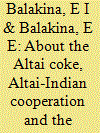

|
|
|
| 2 |
ID:
101040
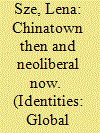

|
|
|
|
|
| Publication |
2010.
|
| Summary/Abstract |
This article explores the intersection of cultural tourism, gentrification, and urban development in the neoliberal period by examining the complex and ambivalent relationship between an "ethnic-specific" cultural institution and a rapidly gentrifying neighborhood. Through a case study of the Museum of Chinese in America's (MoCA) profile, history, and community involvement in Manhattan's Chinatown, this article suggests that small to midsize ethnic-specific museums relate to the social and spatial transformations inherent in gentrification through a mechanism called gentrification consciousness. This mechanism helps to explain how an institution whose history, mission, and politics might indicate a resistance to gentrification is confounded and constrained by the larger neoliberal landscape. Offering little in the way of substantive alternative funding and space, neoliberal urban development touts tourism and culture as key routes to economic development with gentrification as a "natural" and beneficial by-product of such development for both the surrounding neighborhood and for individual cultural institutions. An analysis of the unique relationship of smaller ethnic-specific organizations to gentrification processes complicates discussions about museums and gentrification as well as potentially identifying methods and measures of institutional success that do not rely so heavily on neoliberal logics and policy prescriptions.
|
|
|
|
|
|
|
|
|
|
|
|
|
|
|
|
| 3 |
ID:
180357
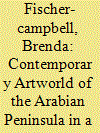

|
|
|
|
|
| Summary/Abstract |
This article analyzes the production and presentation of artworks of three countries of the Gulf Region –– Qatar, the UAE and Saudi Arabia –– to evaluate its place and potential in the globalized artworld. The Gulf region is a small but significant part of the global artworld with high potential for further development. Art globalization in the Gulf began to develop only in the 2000s –– from about 2006 in the UAE, followed by a second wave in Qatar five years later. A third wave is rising with the increasingly international exposure of Saudi Art. The article examines which factors are essential for participation in a globalized art world and whether the region enjoys international recognition on the global stage. A composite artworld ecosystem model comprising institutions, artists and their artworks, commercial entities and government was conceived on a philosophical and sociological basis within a historical and geopolitical framework. The roles of the museum, biennials, art galleries and art fairs, are converging in many respects. All the nodes of the artworld ecosystem are required for globalization, with participation in the biennial model being the most important factor, being more flexible than the museal institutions in funding and programming. To reach a wider audience, the art fair model could be more relevant than the more esoteric biennial format. The Gulf region’s patrons possess strong motivations for supporting the arts of the region internationally. In addition, the desire to enter the global cultural world through the promotion of art museums as a tourist destination is a strong motivator for governments.
|
|
|
|
|
|
|
|
|
|
|
|
|
|
|
|
| 4 |
ID:
151739
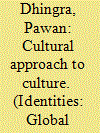

|
|
|
|
|
| Summary/Abstract |
Artifacts and Allegiances: How Museums Put the Nation and the World on Display takes a global approach to how museums make sense of increased globalization and migration. Museums construct narratives that link their locality to the nation and to the world. Peggy Levitt’s major book explains how museums imagine themselves and how they work towards composing a kind of visitor experience. It is about museum visions, missions, and exhibitions as told through the eyes of those who create and are responsible for them, namely, top administrators, curators, politicians, and more. Her analysis explains why museums only a few hundred miles apart can have such different conceptions of how to create the proper citizen. As such, the book illuminates the power of a cultural sociological approach.
|
|
|
|
|
|
|
|
|
|
|
|
|
|
|
|
| 5 |
ID:
095460
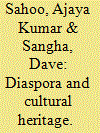

|
|
|
|
|
| Publication |
2010.
|
| Summary/Abstract |
The present paper examines the historical and contemporary context of Indian communities in Canada from a cultural heritage perspective and analyses the processes of migration, settlement and cultural identity. It also examines the challenges of developing museum exhibits which depict the Indian diaspora in Canada. Despite its colourful history and its growing size and prominence in Canadian society, the Indian diaspora has not been the subject of much interest by Canadian museums. While recognising the necessity of working with local communities and thereby reflecting local concerns, it is submitted that any museum exhibit attempting to portray the complex set of experiences of the Indian diaspora in Canada should include some portrayal of the highly marginalised position which the Indian community faced when it first established themselves in the early 1900s. In addition to this historical focus, any attempt to portray the contemporary Indian diaspora needs to portray its growing diversity and its efforts to maintain, and in many cases modify and 'hybridise', cultural practices. Such a display would also have to reflect the influence of transnational forces on the contemporary Indian diaspora. Ultimately, efforts by museums to develop exhibits reflecting the Indian presence in Canada will only further the aims of its widely praised state policy of multiculturalism.
|
|
|
|
|
|
|
|
|
|
|
|
|
|
|
|
| 6 |
ID:
189158
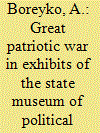

|
|
|
|
|
| Summary/Abstract |
THE GREAT PATRIOTIC WAR, which started 80 years ago, remains both a relevant and painful topic for our country. Russians' interest in those events is supported by numerous works of research and journalism, as well as projects that allow people to trace the fate of their relatives on the battlefields of that war. However, manipulations of public opinion at the global level that seek to belittle the role of our country in the victory over the Axis powers are distorting historical memory and leading to attempts to revise the outcomes of World War II.
|
|
|
|
|
|
|
|
|
|
|
|
|
|
|
|
| 7 |
ID:
153638
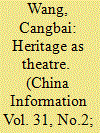

|
|
|
|
|
| Summary/Abstract |
Since China’s signing of UNESCO’s World Heritage Convention in 1985, cultural heritage in China has become a booming industry and a key area of scholarly investigation. The mainstream literature on China’s heritage and urbanization tends to view heritage as a civilizing agent to regulate and improve the urban population. Drawing on Clifford Geertz’s notion of ‘theatre state’ and through a case study of Jiangmen, this article reconceptualizes China’s urban heritage industry as ‘theatre’. It shifts the focus away from neat political rationalities to messy ‘magical assemblages’, such as dramatic museum representation, monumental architecture and expressive ceremonies, in state-led heritage-making processes. It argues that the Chinese government makes heritage by using not only the means of political rationalities but also, and perhaps more importantly, the power of spectacle, sensation and awe. China’s heritage industry is thus as much ‘a technique of enchantment’ as ‘a technique of government’, revealing complicated processes of China’s negotiation with the Western-centred conceptualization of modernity and cultural heritage. Additionally, it draws attention to diasporic resources in urban heritage-making, broadening the existing research that has predominantly focused on the employment of nostalgic and/or exotic appeal for city branding and development.
|
|
|
|
|
|
|
|
|
|
|
|
|
|
|
|
| 8 |
ID:
175121
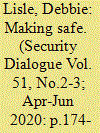

|
|
|
|
|
| Summary/Abstract |
In the Ulster Museum’s new gallery The Troubles and Beyond, the central display showcases a Wheelbarrow bomb disposal robot. This machine was invented by the British Army in Northern Ireland in 1972 and used by officers of the 321 Explosive Ordinance Disposal Squadron (321EOD) to defuse car bombs planted by the Irish Republican Army (IRA). This article offers an alternative history of that machine – a dirtier history – that critically assesses its role during the Troubles. Centrally, the article contests the British Army’s preferred account of this machine as a ‘game-changing’ technological innovation in counterinsurgency, and their understanding of themselves as benign peacekeepers. Rather than figure the Wheelbarrow robot as an unreadable ‘black box’ used instrumentally by the superior human operators of 321EOD, this article seeks to foreground the unruly transfers of agency between the machine and its operators as they tested and experimented in the exceptional colonial laboratory of Northern Ireland. The article further explores the machine’s failures during bomb disposal episodes, the collateral damage that resulted, and the multiple and often unruly reactions of local populations who watched the Wheelbarrow robot at work. Providing a ‘dirty history’ of the Wheelbarrow robot is an effort to demonstrate that war can never be fully cleaned up, either through militarized mythologies of technological innovation or hopeful museum displays.
|
|
|
|
|
|
|
|
|
|
|
|
|
|
|
|
| 9 |
ID:
114861
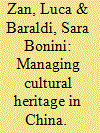

|
|
|
|
|
| Publication |
2012.
|
| Summary/Abstract |
This article investigates change processes regarding the managerial aspects of organizing cultural heritage activities in China. The focus is not on the historical and artistic meanings of archaeological discoveries in themselves; nor on the technical, scientific and methodological repercussions of conservation and restoration; nor on the evolution of museology per se. Rather, the core of the analysis is on new managerial problems along the "archaeological chain" (archaeological discoveries, restoration, museum definition and public access to cultural heritage) posed by new professional discourse and the overall evolution of the economic and political context. The article is based on field research carried out in Luoyang, Henan province. The micro view adopted (managing practices more than policies), and the unusual access to data (including financial figures on individual entities) represent a unique opportunity for a sort of "journey" inside the Chinese public sector.
|
|
|
|
|
|
|
|
|
|
|
|
|
|
|
|
| 10 |
ID:
134421
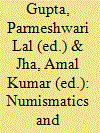

|
|
|
|
|
| Publication |
Nashik, Indian Institute of Research in Numismatics Studies, 1987.
|
| Description |
143p.Pbk
|
| Contents |
2nd International Colloquium
|
|
|
|
|
|
|
|
|
|
|
|
Copies: C:1/I:0,R:0,Q:0
Circulation
| Accession# | Call# | Current Location | Status | Policy | Location |
| 057921 | 737.4954/GUP 057921 | Main | On Shelf | General | |
|
|
|
|
| 11 |
ID:
103856
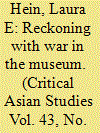

|
|
|
|
|
| Publication |
2011.
|
| Summary/Abstract |
How do people handle their regret at having believed that a foolish war was not just acceptable but necessary? Japan after World War II provides an instructive example. Many contrite Japanese revisited the aesthetic realm, looking for ways to interpret culture that did not convey the values of fascism, such as glorifying willing surrender to a powerful leader. They saw their task as engendering an individual aesthetic and therefore political subjectivity, so that Japanese would in the future more bravely resist state violence at home and abroad. These individuals saw culture as intrinsically political rather than as a refuge from politics. Recognizing the difficulty in countering fascist culture through ideas alone, they also created what economists today call "capacity building" institutions to help them do so, such as Japan's first museum dedicated solely to modern art, the Kamakura Museum of Modern Art, established in 1951. The founders of the Kamakura Museum self-consciously set out to create a new institution that would embody a democratic aesthetic and so prevent-they hoped-Japan from repeating the disastrous experience of war. The curators argued for diverse and dynamic modernities, a concept that parried both the idea that artistically Japan was a pale copy of modern Europe and the notion of a single national culture in Japan or elsewhere. At the same time, however, the legacy of the war was visible in an entirely different and less admirable way in the museum curators' stance toward Asian modernity beyond Japan and its evasion of Japan's responsibility for the wartime devastation of China.
|
|
|
|
|
|
|
|
|
|
|
|
|
|
|
|
|
|
|
|
|